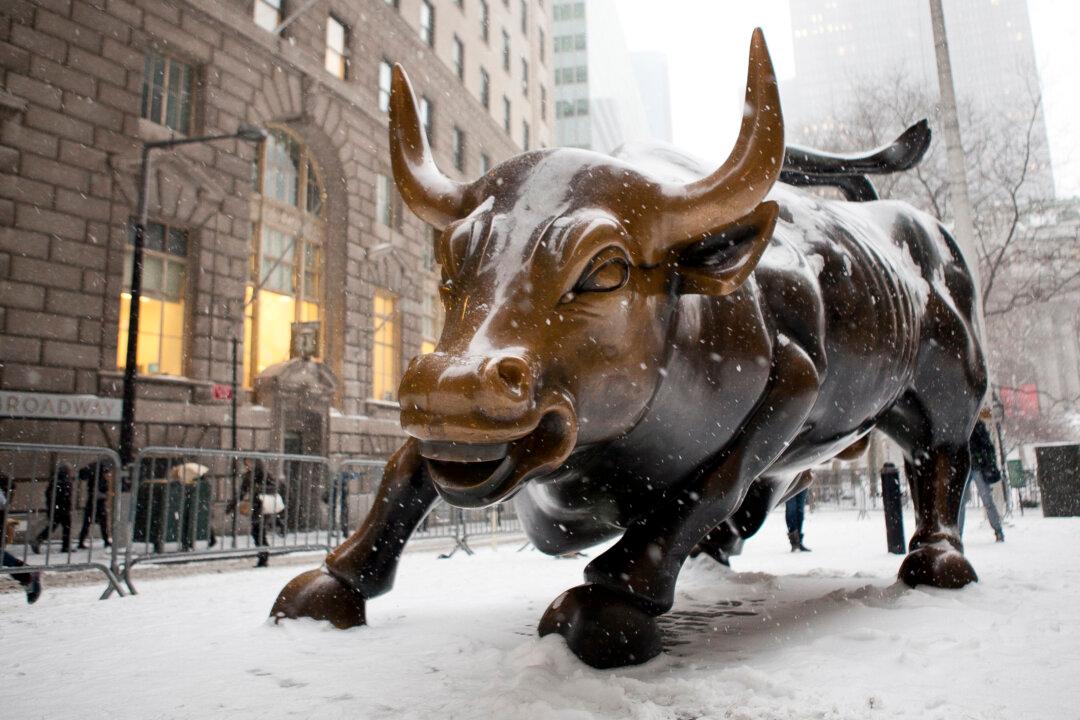Although stocks are trading at record levels, the bull market could easily run equities up another 25 percent, even against the backdrop of slower economic growth abroad.
The sagging fortunes of other advanced economies are mostly caused by structural problems that are unlikely to abate—for instance, in the European Union, the rigidity imposed by a single currency; in Japan, the low birth rate; and in both places, the inflexible labor markets and business regulations.
Those situations compel the European Central Bank and the Bank of Japan to keep interest rates low, and, to the extent that their charters and politicians permit, to purchase long-term government bonds and private securities.
That pushes European and Japanese private investors to seek alternatives in foreign markets, and the preferred venues are China and the United States where the economy and corporate profits are growing. The most likely targets are U.S. multinationals and Chinese companies listed on U.S. and other foreign exchanges, because U.S.-listed Chinese companies adhere to higher accounting standards, and their finances are more transparent than other Chinese companies.
The Bank of Japan and the Japanese Government Investment Pension Fund are flush with domestic securities and are purchasing domestic and foreign stocks directly, which is a profound development. With Japan’s population aging, Japanese leaders are increasingly financing future retirement obligations, which cannot be carried by investment opportunities in Japan alone.
At the same time, digital technologies are permitting U.S. and Chinese entrepreneurs to create competitive enterprises large and small—like Google and Uber—with much less capital and more quickly.
Little more than a decade ago, Google was launched with only $25 million in capital. Exploiting a novel search engine with off-the-shelf servers and the free Internet, it accomplished worldwide reach and a market capitalization of $23 billion, a 900 percent increase, in just six years.
Similarly, digital technologies permit established companies to improve existing products and create new consumer offerings at lower design costs and to use machinery and workers more efficiently through better supply-chain management.
Consequently, big U.S. companies require less capital to remain competitive and grow and are flush with billions in cash. Along with money managers, they bid up prices acquiring young companies, whose owners are looking to cash in on their initial success, and continue to purchase back large blocks of their own stock.
Taken together, those forces have pushed stocks to record levels and pushed down yields on corporate and government debt.
The average rate of profits (annual profit margin minus dividends paid plus returned earnings divided by current share prices) for companies composing the Standard and Poor’s 500 Index is 5.2 percent, and that compares quite favorably with the 2.3 percent paid on 10-year Treasuries.
Investors remain cautious in that the Federal Reserve could push up interest rates on government bonds enough to dampen stock prices in 2015, but weak economic conditions in Europe and Japan—and geopolitical risks in Eastern Europe, the Middle East, and elsewhere—will likely constrain the Fed’s enthusiasm for higher long-term rates.
Also, bond prices would fall directly as interest rates rise; hence the downside risk of losing market value, posed by the Fed raising interest rates, is greater and more certain for bondholders than it is for stockholders.
The S&P 500 Index is trading at about 2050, with a price-to-earnings ratio of 19.1. Factoring in expected profit growth over the next 12 months, that ratio falls to 16.9.
Over the past 25 years, the index’s P/E ratio has averaged 18.9, and when it first crossed the 1000 threshold in 1998, the ratio was about 25.
Assessed against alternative investments and history, and given how quickly and efficiently digital technologies permit entrepreneurs and established businesses to create wealth using investors’ cash, stocks are hardly overvalued.
A P/E ratio approaching 25 is a reasonable target, even as the Fed tightens monetary policy moderately in 2015. That would put the S&P index at above 2500.
Peter Morici, professor at the Robert H. Smith School of Business at the University of Maryland, is a recognized expert on economic policy and international economics. Previously he served as director of the Office of Economics at the U.S. International Trade Commission. Follow @pmorici1





